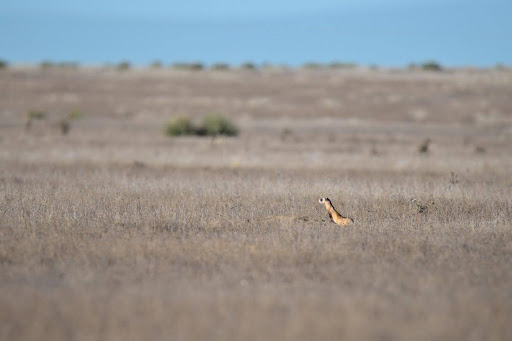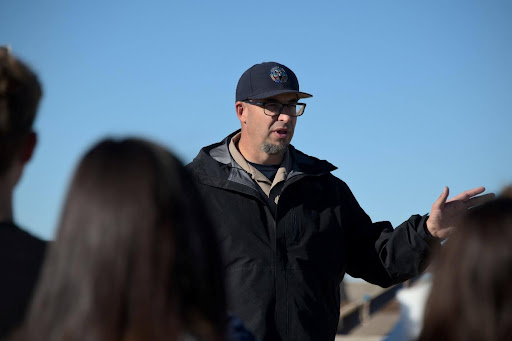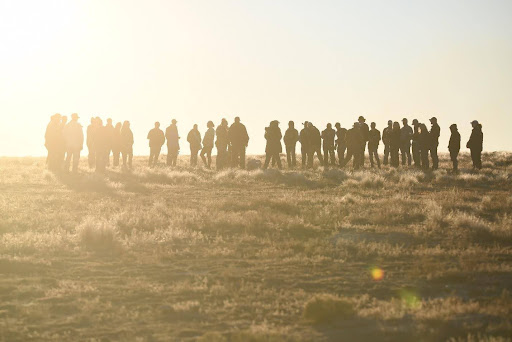The air was full of ferret chitters and children’s chatters as students from Lamar Middle School helped Colorado Parks and Wildlife (CPW) release black-footed ferrets. The May Ranch in Lamar, Colorado would become the new home of these animals, which are members of one of the most endangered species in North America.
Two students were assigned for each ferret being released, working in tandem to ensure these animals entered their first prairie dog burrows successfully. The swift and defensive nature of the ferrets earned some fitting nicknames from the children, such as “Subspace,” who was quick to vanish down its burrow upon release.
The ferrets are raised in facilities at six zoos in North America before arriving at “ferret boot camp,” in the National Black-Footed Ferret Conservation Center. Once they are old enough and have proven their ability to hunt prairie dogs, they are transported to their release site. Fourteen kits, each roughly six months old, and three adults have made it through boot camp.
For the ferrets, this next phase is a hard time. They have never seen a badger face-to-face, nor had an owl swoop down on them. They must face the daily challenge of survival in their new home. Each ferret is given a dead hamster to provide a nutritional boost as they learn to hunt in their new environment. This will be the last easy meal of their lives.
The kits are released at six months of age during the fall, the natural dispersal time when they leave their mother’s protection to live as independent adults.
The first year is critical. On average, ferrets will only breed three times in their lives. The younger the ferret is released, the greater the chance for natural-born litters.
Kits born into the wild have far better survival odds than those born in captivity and released.
To survive, ferrets must rely on the prairie dog, a keystone species whose burrows provide shelter and whose meat makes up 90% of their diet. A keystone species is one whose fate is intertwined with an ecosystem’s health. A stone arch with no keystone will collapse just as an ecosystem without its keystone species cannot function.
Without the prairie dog, there can be no ferrets. Only 2% of prairie dog populations remain in the United States. In the 1800s, the plow converted the prairie dog habitats into farmland. Landowners tried to remove the remaining prairie dog populations by poisoning them.
Today, disease poses the greatest threat—specifically, the sylvatic plague, a relative of the infamous black plague. The Sylvatic plague is spread by flea bites. This disease can infect many mammals, including prairie dogs, mice, deer, ferrets, and even humans.
Flea powder treatments and edible prairie dog vaccines are the most useful tools that CPW implements to save prairie dogs, which benefits the ferrets.

The black-footed ferret is an umbrella species; protecting it means protecting other animals that the ferrets depend on for survival.
Only one wild population of ferrets remained in South Dakota. By 1985, sylvatic plague rushed through the ecosystem, crashing the population.
The US Fish and Wildlife Service (FWS) captured as many ferrets as possible to save the species. Only 18 ferrets were captured. The wild population was lost to the plague.
These 18 individuals formed the bedrock for all ferrets in North America today.
According to Tina Jackson, the Black-Footed Ferret Recovery Coordinator for the FWS, roughly 500 wild ferrets are estimated to live in the wild. At the May Ranch, CPW’s goal is to have a population of at least 30 breeding ferrets. However, the current determination of successful reintroduction is less about population counts and more about the number of kits born on the property.
Counting an animal that spends over 22 hours a day underground is not easy nor realistic, after all.
Bringing a species back from certain extinction is no easy feat. For ferrets, it’s taken the partnership of 50 agencies including CPW, FWS, and Natural Resource Conservation Service, to name a few.
It “takes more than a tribe to get us where we are now … we are standing on the shoulders of giants,” said Jonathan Reitz, Wildlife Biologist with the CPW.

Reitz emphasized the importance of this collaboration, especially with private landowners while educating the students about ferret conservation efforts.
At the end of the day, the best ferret habitats are large expanses of flat prairie; most of this habitat is found on private lands in Colorado. What Dallas May, owner of the May Ranch, has done in collaboration with CPW is nothing short of inspirational.
He has designated his land as a conservation easement, which forever limits extensive development to allow prairie dog habitats to expand and remain sustainable. As part of this easement, Dallas and the May Ranch have allowed CPW to release ferrets on the property, and conduct capture surveys to see how the animals do.
In September, students from Western Colorado University assisted CPW in conducting nightly black-footed ferret surveys as part of Dr. Pat Magee’s Wildlife Management Techniques course. The teams drove throughout prairie dog colonies using spotlights to locate the ferrets. These surveys help CPW monitor how well the ferrets are adapting to life on the ranch and determine whether observed individuals were either released there or born in the wild.
There are 1,400 acres of active prairie dog colonies on the May Ranch. The May Ranch used to have over 3,000 to 4,000 acres of prairie dog colonies, however an outbreak of plague brought this down to the current range we see today. Dallas and the CPW want to increase this prime ferret habitat to 4,000 to 5,000 acres.
This doesn’t just benefit ferrets. As a keystone species, prairie dogs create food and shelter opportunities for numerous other animals—including the threatened burrowing owl. Like the ferret, burrowing owls use prairie dog burrows for shelter. Out of an estimated 5,000 to 10,000 burrowing owls in Colorado, 500 take refuge on the May Ranch.
The success rate for ferret release sites hovers around 50%. The May Ranch just celebrated its first confirmed wild kit birth this year, detecting seven to nine animals during their recent surveys.
To put this in perspective, 75 ferrets were released on the Southern Plains Land Trust, another release site in Colorado. Only two animals were sighted in fall 2024.
As Reitz states, the reintroduction of ferrets into Colorado requires the enthusiasm and support of private landowners. Ranchers who declare their lands as conservation easements are committed to service the endangered prairie ecosystem conservation. In a time where 50% of grassland ecosystems in Colorado have been lost, we need more landowners to take a page from Dallas’ book.
Not long ago landowners who neighbored ferret release sites would work with the FWS to eliminate prairie dogs from their lands to avoid the Endangered Species Act (ESA) regulations. Under these rules, ranchers cannot freely manage prairie dogs. Should ferrets expand from the release site onto neighboring properties, these regulations would be enforced on unwilling landowners, creating conflict.
Thankfully, these conditions have changed under the Safe Harbor Agreement, a voluntary agreement between the FWS and the landowner that prevents ESA regulations from affecting their ability to manage prairie dogs should a ferret appear on their property. This effectively removed the incentive to exterminate prairie dogs on their lands to avoid ESA restrictions.
As the sun began to set, the CPW Commission came to release the last three adult ferrets. These animals are retirees from the program, unlikely to breed but still important to release—keeping them in captivity risks domestication, reducing the wild instincts that make black-footed ferrets such efficient hunters.
These hunting instincts will be crucial for their survival. While prairie dogs are their primary prey, they’re far from defenseless. Over millennia, prairie dogs and ferrets have evolved in an impressive arms race. When ferrets are released into a burrow, prairie dogs try to trap them by plugging the tunnel entrances with dirt. But the ferrets’ natural predatory drive helps them overcome these defenses, allowing them to survive and thrive when conditions are right
The future of black-footed ferrets rests on the shoulders of every kit released across 34 sites in the United States. To begin delisting talks, ferret populations must reach at least 3,000 animals in the lower 48 states. We are a long way off, but in Reitz’s words, things are “looking brighter for ferrets.”

